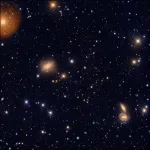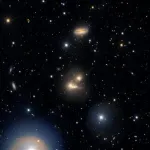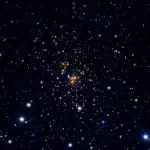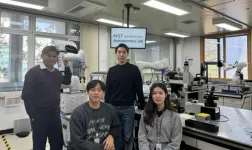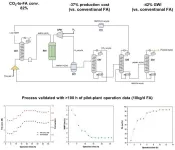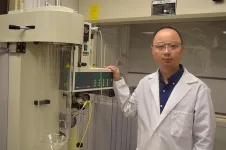(Press-News.org)
FOR IMMEDIATE RELEASE
Distant, far away galaxies. Interacting galaxies, whose shape has been forged by the mutual gravitational influence, but also galaxies forming groups and clusters, kept together by gravity. They are the protagonists of three new images released by the VLT Survey Telescope (VST).
VST is an optical telescope with a 2,6 diameter mirror, entirely built in Italy, that has been operating since 2011 at the European Southern Observatory’s (ESO) Paranal Observatory in Chile. Since 2022, the telescope has been fully managed by INAF through the National Coordination Centre for VST, based at the INAF premises in Naples. VST is specialised in observing large areas of the sky thanks to its wide field camera, OmegaCAM, an actual “cosmic wide-angle lens” able to capture, in each shot, one square degree of the sky, a portion of the celestial vault twice as large as the full Moon’s apparent diameter on each side. Besides images for astrophysics research, spanning from stars to galaxies all the way to cosmology, in the past year the telescope has conducted a new programme dedicated to the general public, observing nebulae, galaxies and other iconic objects during some full Moon nights, when the brightness of our natural satellite disturbs the collection of scientific data. More images will be published in the coming months.
“Besides scientific research, one of the goals of the VST Centre is to disseminate scientific knowledge and to share the wonders of the Universe with the general public. We especially wish that young people can discover and nurture their interest in astrophysics through these amazing images”, notes Enrichetta Iodice, INAF researcher in Naples and responsible for the national Coordination Centre for VST.
One of the three new images portrays ESO 510-G13, a curious lenticular galaxy about 150 million light years from us, in the direction of the Hydra constellation. The central bulge of the galaxy stands out. The dark silhouette of the dust disk, seen from the edge, crosses the bulge, obscuring part of the light. The disk’s distorted shape, vaguely resembling an upside-down S, indicates the turbulent past of ESO 510-G13, which may have acquired its current appearance following a collision with another galaxy. In the lower right corner, among the many stars of the Milky Way scattered across the image, a pair of spiral galaxies about 250 million light years from us are also visible. Zooming into the image, many more galaxies appear, even at greater distances, as small spots of light elongated among the many dots in the background.
The second image shows a small group of four galaxies, called Hickson Compact Group 90 (HGC 90), which is about 100 million light years away from Earth, towards the Piscis Austrinus constellation. The two round, bright spots near the image centre are the elliptical galaxies NGC 7173 and NGC 7176. The bright streak that bifurcates and connects these two galaxies is the third member of the group, the spiral galaxy NGC 7174: its curious shape indicates the ongoing interaction between the three celestial bodies, which has stripped their stars and gas, mixing up their distribution. A halo of diffuse light envelops the three galaxies. The fourth galaxy belonging to the group, NGC 7172, visible in the upper part of the image, does not seem to participate in this celestial dance: its core, crossed by dark clouds of dust, hides a supermassive black hole that has been actively devouring the surrounding material. The HGC 90 quartet of galaxies is embedded in a much larger structure, including dozens of galaxies, some of which are visible in this image.
The third image shows a much richer and even more distant grouping of galaxies: the Abell 1689 galaxy cluster, which can be observed in the direction of the Virgo constellation. Abell 1689 contains more than two hundred galaxies, mostly visible as yellow-orange blobs, whose light has travelled for about two billion years before reaching the VST. The enormous mass, including enormous quantities of hot gas and of the mysterious dark matter in addition to the galaxies, deforms space-time in the vicinity of the cluster. Therefore, the cluster acts as a “gravitational lens” on more distant galaxies, amplifying their light and producing distorted images, much like what a magnifying glass does. Some of these galaxies can be spotted as dots and tiny, slightly curved lines, especially around the cluster's central regions.
For further information:
Visit the VST website: https://vst.inaf.it/
Contacts:
INAF Press Office - Marco Galliani, +39 335 1778428, ufficiostampa@inaf.it
END
In the early 20th century, the development of a catalyst for ammonia synthesis by the Haber-Bosch method took more than 10,000 experiments before it was successful. The development of new materials is a time-consuming and costly process from design to commercialization. However, in recent years, researchers have been working to shorten the development period by using artificial intelligence (AI). When combined with robots, it is possible to conduct material development research 24 hours a day, 365 days a year without human ...
CCU (Carbon Capture & Utilization), which captures CO2 and converts it into useful compounds, is crucial for rapidly transitioning to a carbon-neutral society. While CCS (Carbon Capture & Storage), which only involves CO2 storage, has entered the initial commercialization stage due to its relatively simple process and low operational costs, CCU has only been explored at the research level due to the complexity of conversion processes and high production costs of compounds.
Dr. Lee Ung's team at the Clean Energy Research Center ...
Embargoed for release until 5:00 p.m. ET on Monday 6 May 2024
Annals of Internal Medicine Tip Sheet
@Annalsofim
Below please find summaries of new articles that will be published in the next issue of Annals of Internal Medicine. The summaries are not intended to substitute for the full articles as a source of information. This information is under strict embargo and by taking it into possession, media representatives are committing to the terms of the embargo not only on their own behalf, but also on behalf of the ...
KEY TAKEAWAYS
In a study of outpatient sites, researchers found that 7% of patients experienced at least one adverse event and 1.9% of patients experienced at least one preventable adverse event.
The most common adverse events in the outpatient setting were adverse drug events.
The findings highlight an urgent need to develop interventions to prevent both inpatient and outpatient harm.
Over the last several decades, research has brought nationwide awareness to issues of patient harm in the “inpatient” setting, where patients ...
MIAMI, FLORIDA (EMBARGOED UNTIL MAY 6, 2024 AT 3:00 P.M. EDT) – Researchers at Sylvester Comprehensive Cancer Center at the University of Miami Miller School of Medicine have developed a nanoparticle that can penetrate the blood-brain barrier. Their goal is to kill primary breast cancer tumors and brain metastases in one treatment, and their research shows the method can shrink breast and brain tumors in laboratory studies.
Brain metastases, as these secondary tumors are called, most commonly arise from solid tumors like breast, lung and colon cancer and are often associated with a poor prognosis. When cancer breaches ...
Engineers at Princeton and North Carolina State University have combined ancient paperfolding and modern materials science to create a soft robot that bends and twists through mazes with ease.
Soft robots can be challenging to guide because steering equipment often increases the robot’s rigidity and cuts its flexibility. The new design overcomes those problems by building the steering system directly into the robot’s body, said Tuo Zhao, a postdoctoral researcher at Princeton.
In an article published May 6 in the journal PNAS, the researchers describe how they created the robot out ...
Scientists at the University of Colorado Boulder and Princeton University have, for the first time, employed a tool often used in geology to detect the atomic fingerprints of cancer.
In a case of medicine meets earth science, the researchers discovered that cancer cells may be made from a different assortment of hydrogen atoms than healthy tissue. The findings could give doctors new strategies for studying how cancer grows and spreads—and may even, one day, lead to new ways to spot cancer early on in the body.
The team, led by CU Boulder geochemist Ashley Maloney, will publish its findings this week ...
WEST LAFAYETTE, Ind. — Qi “Tony” Zhou, a researcher in Purdue University’s College of Pharmacy has received a $2.4 million grant from the National Institutes of Health to fight lung infections that have established a resistance to antimicrobial drugs.
Zhou is an associate professor in the Department of Industrial and Molecular Pharmaceutics, a Faculty Scholar and a faculty member of the Purdue Institute for Drug Discovery and the Purdue Institute of Inflammation, Immunology and Infectious Disease. He leads a team of multinational experts from Australia, Thailand and the United States in developing novel, patent-pending ...
Researchers at the University of Pittsburgh and Drexel University in Philadelphia, along with Brookhaven National Laboratory, are working to solve a multipart mystery to make water disinfection treatments more sustainable.
Scalable electrochemical ozone production (EOP) technologies to disinfect dirty water may someday replace centralized chlorine treatments used today, whether in modern cities or remote villages. However, little is understood about EOP at the molecular level and how technologies that make it possible can be made to be efficient, economical, and sustainable.
Their research, “Interplay between Catalyst Corrosion and Homogeneous Reactive Oxygen Species ...
Images
The U.S. Office of Naval Research is tapping academic expertise at the University of Michigan to solve current and future problems, Secretary of the Navy Carlos Del Toro announced during his visit to campus over graduation weekend.
The $14.5M Center for Naval Research and Education will also help train an engineering research community familiar with naval and marine applications.
"I am incredibly proud of the partnership between the University of Michigan and the Department of the Navy. Michigan is a key teammate in rebuilding our shipbuilding industry and restoring the comprehensive—commercial ...
